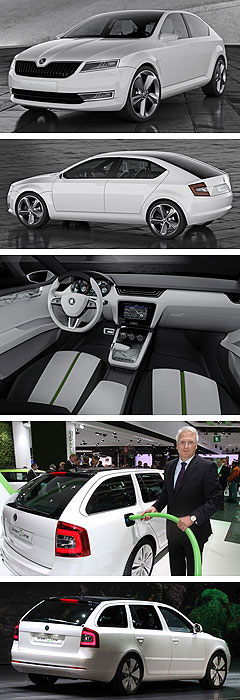Frankfurt show: Skoda unveils its Focus fighter
BY MIKE COSTELLO | 6th Sep 2011

The MissionL concept, which will make its public debut at the Frankfurt motor show next week, is our clearest look yet at what the company has in store for its crucial sixth model line.
While the pair of shadowy images revealed this morning appear to show a sedan, Skoda is saying the car will be configured as a compact liftback.
The concept features a chunky C-pillar and side profile reminiscent of the larger Volkswagen Jetta, while the slab-sided doors are broken up by a broad ridge line running underneath the window-line.
The sharply-raked rear window line gives way to trapezoidal tail-lights, while the roughly V-shaped grille design seems to borrow from the recent VisionD design concept first seen at the recent Geneva show.
The only aspect of the car that looks likely to change drastically are the narrow door-handles – borrowed straight from the VisionD – which are almost certain to be replaced with more functional units.
Indeed, Volkswagen’s Czech subsidiary has indicated that its latest design study closely resembles the final road-going version of the car. Along with the VisionD, it confirms the brand is in no hurry to diverge too far from its signature boxy styling language.
Skoda’s Australian chief Matthew Wiesner recently told GoAuto that a small-car contender was hugely important to the local subsidiary’s ambitious growth plans.

“If you’re not in that (small segment), you’re not going to drive the brand where you need to go from a volume point of view,” he said. “That’s vital for us here.” The company’s board chairman, Professor Winfried Vahland, said: “The MissionL shows exactly the direction our brand is going to take. The world premiere in Frankfurt gives a clear signal that Skoda is going full steam ahead now.” In line with what Skoda calls its “internationalisation principles”, the compact five-door will be launched across Europe, Russia and China. The car will get specific modifications to suit each region, while the Indian market will also get its own small-sedan version by the end of the year.
Overseas reports have speculated that the car – which will join the Fabia (due here in September), Octavia, Roomster, Superb and Yeti (due October) – will be called the Lauretta.
Rumours also abound that VW’s entry-level brand could dust off the old Felicia badge, which adorned a small-car and a Proton Jumbuck-style light commercial derivation between 1994 and 2001.
Whatever it is called, Skoda’s take on the Ford Focus will slot neatly into the brand’s portfolio between the Fabia and the Octavia, which Mr Weisner says will grow into a true D-segment vehicle when the next-generation model appears in 2013.
“(Octavia) sort of slips into small but obviously plays in medium,” he said. “That will change when the new one comes - it will be more of a typical medium-sized car.” The next Octavia is also likely to borrow from the VisionD liftback design concept, which featured a cleaner new grille and super-narrow straight-edged headlights.
Both the 2012 small-car and the 2013 Octavia will form important cogs in the company’s stated goal of achieving 1.5 million annual sales globally by 2018.
In an intriguing indication of how serious Skoda is about achieving this goal, Professor Vahland said the company was gearing up to present a new vehicle “every six months over the next two or three years.” As well as the small-car and the Octavia, the company is set to launch an all-new city-car based on VW’s all-new Up, which will also be presented at Frankfurt and could be sold here by late next year, while a seven-seat SUV – in which Mr Wiesner has indicated a strong interest – is also a possibility, although details on that car remain sketchy.
Globally, the marque is on track to break its all-time annual sales record this year, with 523,000 units delivered to the end of July.
Skoda also announced recently that it is producing a test fleet of 10 all-electric Octavia Green E-Lines based on the wagon concept shown at the Paris show last October.
The company says the test fleet will be used to gather information on the useability, reliability and safety of the electric drivetrain. Parent company Volkswagen, meantime, is already onto its second fleet of Golf Blue-e-motion electric test cars.
One of the bigger vehicles to feature an EV powertrain, the Octavia Combi E-Line gets its impetus from an electric motor with a constant 60kW (85kW maximum) of power and 270Nm of peak torque – all of which is characteristically available from the get-go.
Energy for the motor is provided by a 26.5kWh lithium-ion battery pack stored in the vehicle’s modular floor unit. The 315kg battery pack gives the car a respectable claimed range of 150km with the help of brake energy recovery.
Skoda claims the family wagon will accelerate to 100km/h in 12 seconds on its way to a top speed of 135km.
Closer to home, Skoda announced earlier this week that its entire Australian line-up, currently comprised of the Octavia and Superb, will now get standard Bluetooth phone connectivity at no extra cost.
The hands-off technology also includes audio streaming and phone book display and will be fitted in all model year 2012 cars, which have been arriving on our shores since August.
As we’ve reported, it will be full steam ahead for the brand’s Australian arm with the launch of the light Fabia hatch range and the small Yeti crossover set to double its current range inside two months.
More Fabia variants – such as the wagon, RS hot-hatch and optional DSG dual-clutch automatic transmissions – will join the range from early 2012, while the oddball Roomster van will also be relaunched with revised petrol engines at what Skoda has said will be a “very aggressive” price point.